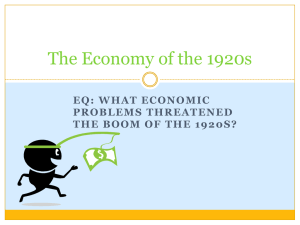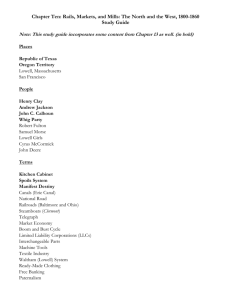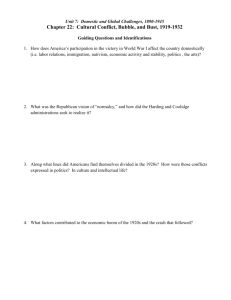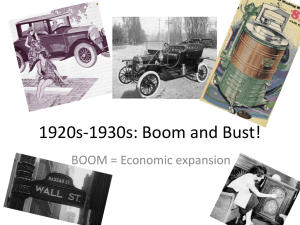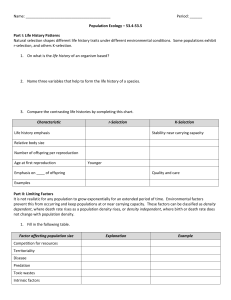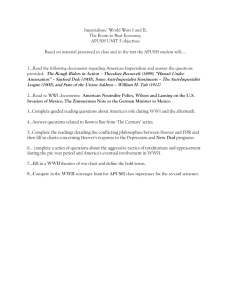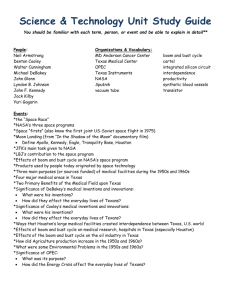U.S. Housing Boom-Busts in Historical
advertisement
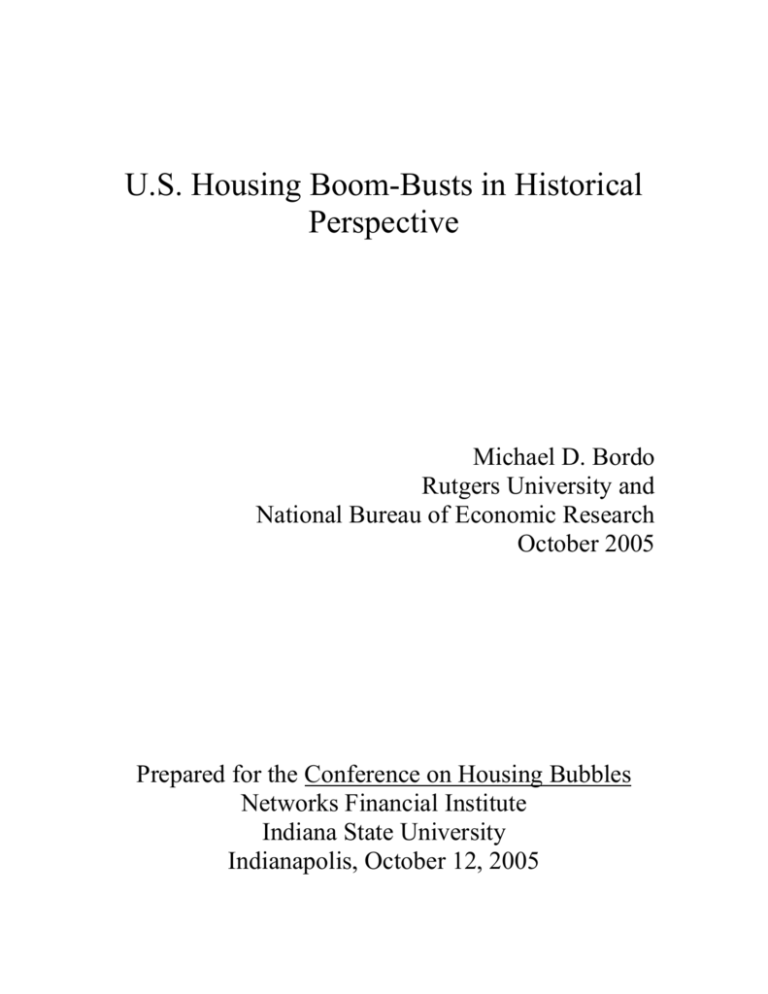
U.S. Housing Boom-Busts in Historical Perspective Michael D. Bordo Rutgers University and National Bureau of Economic Research October 2005 Prepared for the Conference on Housing Bubbles Networks Financial Institute Indiana State University Indianapolis, October 12, 2005 “U.S. Housing Price Boom-Busts in Historical Perspective” I. Introduction There is present concern that housing prices in the U.S. are undergoing an unsustainable boom, which some refer to as a bubble, which will end in a bust with dire consequences for the real economy. The collapse of the housing market, it is posited, will reduce investment in housing and related industries, reduce householder’s wealth and thereby reduce consumption. A rise in mortgage indebtedness will precipitate defaulters and will weaken mortgage related financial institutions and in turn threaten financial stability. Some critics blame the Fed for not acting preemptively to stem the crisis and for creating it in the first place by following a low interest policy in 2000-2002. This paper considers whether this dire scenario is likely to happen. My reading of the research on the housing boom makes me skeptical. The U.S. has had a long history of housing booms which were regional or local. It never experienced a national housing boom-bust and this episode will likely repeat the experience of the past. Section II looks at recent international evidence on housing booms and busts. The record shows that over the past 35 years housing boom busts did occur in a number of countries and they were associated with significant declines in real output. The U.S. (and Canada) are exceptions. Section III considers the current debate over whether the U.S. is ripe for its first national housing financial crisis. Much recent serious research suggests the answer is no. Section IV presents some anecdotes from U.S. financial history that illustrates the regional/local nature of housing boom-busts. Section V concludes with some issues for monetary policy. I distinguish between real and pseudo financial crises. The case for monetary policy action depends on whether the housing boom-bust, if it occurs, is a real financial crisis impinging on the payments mechanism and the banking system. If it does not threaten the banking and payments systems then as Schwartz (1986) argued, it is a pseudo crisis and hence not the direct object of central bank action. However if asset price boom busts do spill over into the 2 financial system then the policy issue is whether the Fed should act preemptively or proactively. This issue is still moot. Section II. The International Evidence Bordo and Jeanne (2002), Helbling (2003) and the IMF WEO (2003) present evidence based on the experiences of 14 OECD countries 1973-2000 which shows that there have been frequent housing booms in isolation and frequent housing busts in isolation and somewhat less frequent combined boom-bust episodes. Their research using different metrics finds that 40-50% of housing booms led to busts. Bordo and Jeanne (2002) identify booms and busts by comparing a moving average of the growth rate in asset prices (both equity and property) with the long run historical average. They identify a boom/bust when the 3 year moving average of the growth rate of the asset falls outside a confidence interval defined with respect to the historical first and second moments of the series. Figure 1 shows the log of real property prices with booms and busts demarcated for 14 countries. We define a boom-bust episode as a boom followed by a bust starting no later than one year after the end of the boom. We find that out of 19 booms in property prices, 10 were followed by busts. Thus the probability of a boom in property prices turning into a bust is 52%. As can be seen the U.S. never experienced a boom-bust. This may reflect the fact that boom-busts in property prices that occurred in New York, California and New England in the 1980’s and 90’s washed out in the national index employed. Similar results for the OECD countries are produced by Helbling (2003) whose work is based on the WEO (2003). He uses business cycle dating methods to determine turning points in the level of housing price indices. These points demarcate bull and bear markets in housing. Within the full set of bull and bear market episodes, booms (busts) are identified as episodes with large price changes—those in the top (bottom) quartiles of the trough to peak (peak to trough) changes. Using this metric, only 6 out of 16 booms ended in a bust—the probability of a boom turning into a bust is 40%. As in Bordo and Jeanne (2002), the U.S. is not one of them. See Figure 2. 3 Both articles use an event study methodology to show that boom-bust episodes are associated with significant declines in real growth (see figure 3 for the Helbling result) and with reversals in private credit (see figure 4 from Helbling). Bordo and Jeanne show that boom-busts are also in a few cases associated with banking crises. Thus the international evidence suggests that house-price boom-busts are a serious issue. III. The U.S. Experience 2000-2005 The international evidence considered above was based on the period before 2000. The current concern over the U.S. focuses on the past few years. Figure 5 presents an annual house price index constructed by Shiller (2005) from 1890 to 2005. As is evident, by 2005 U.S. house prices (deflated by the CPI) were 67% above their 19501995 average. This evidence for an unsustainable boom is then combined with two other metrics: the ratio of house prices to house owners equivalent rent and the ratio of house prices to median family income. See figure 6. The former metric is the housing market’s equivalent of the stock market’s price earnings ratio, the latter is a measure of affordability. The recent runups in both metrics and in the real price of housing as well as surveys of home buyers in selected cities is the evidence that Case and Shiller (2003) give that the U.S. is in a housing bubble. Cecchetti (2005) concurs. Aliber (2005) argues that a bubble, defined as an increase in prices driven by expectations of future price rises and not by fundamentals, is present from the fact that the rental rate of return on housing is well below the long-term bond yield. This he argues reflects buyers of real estate’s anticipation that property prices will rise to more than compensate for the yield spread. He predicts at least a 20% collapse in housing prices nationwide. Others disagree that the U.S. is experiencing either a housing bubble or a boom that will necessarily turn into a bust. Himmelberg et al (2005) critique the measurement of the price rental (price income) ratio used by the bubble proponents. According to them the correct way to approach the issue is to calculate the user cost of home-ownership. Their calculations for 12 U.S. real estate markets show that the standard price rental ratio 4 is vastly biased upwards because improper account is taken of the decline in mortgage interest rates that has occurred in the past few years. Their calculations of the ratio of imputed user cost to the actual rent do not reveal significant misalignment even in cities like San Francisco, San Diego and Boston which are commonly believed to be experiencing bubbles (see figure 7). McCarthy and Peach (2004) are also critical of the measurements frequently used. They argue that the OFHEO repeat sales index that is often used to make the case for an unsustainable boom does not adequately adjust for improvements in the quality of housing over time. They show that using the U.S. Bureau of the Census constant-quality new home price index, which is based on hedonic methods, eliminates much of the recent runup in the price rental ratio. Others have argued that focusing on a national housing price index for the U.S. as a whole masks the great heterogeneity of the market. Local and regional markets differ considerably across the country depending on the supply elasticity of land available for construction. In some markets such as in California and the northeast, because of environmental regulations (Glaeser et al, 2005) and other geographical restrictions, supply is highly inelastic. This is compared to metropolitan areas in the midwest or southwest where land suitable for construction is readily available. In addition, housing demand differs considerably across markets. Gyourko et al (2004) document the phenomenon of “superstar” cities like San Francisco, which are places favored by high income people because of their special amenities such as favorable climate, beautiful view and the presence of world class universities. These people are willing to pay a premium to live there. Indeed, according to them, house prices rise more rapidly in these cities than elsewhere reflecting the interaction between inelastic supply and the thickening of the right tail of the national income distribution. In sum, important fundamentals can explain both the recent patterns of the price rental and price income ratios and the reasons why the geographical dispersion of U.S house prices is so great and furthermore why some areas seem more prone to house price booms than others. According to this view however, changing fundamentals like a recession or a rise in mortgage rates could trigger an end to such booms. Unlike the bubble scenario a collapse is not inevitable. 5 IV. U.S. History U. S. history (and that of virtually every country) is replete with stories about housing and land booms and busts. Most had a common feature, a new territory was opened up, (or a new resource discovered), with perceived desirable economic opportunities. Often more people arrived than could possibly exploit the resources. Booms thus reflected excess demand by new residents for the supplies of new housing which was temporarily limited by transportation, gestation and other costs. Some of these booms may have turned into what Kindleberger (1978) called manias when people speculated on future capital gains. Promoters and others sometimes fraudulently marketed inaccessible or worthless properties. Many booms turned to busts as the perceived economic opportunities failed to materialize. The bust in turn destroyed wealth and weakened financial balance sheets often leading to local bank failures. None of these boom busts seriously impacted the national real economy or the financial and banking systems. Classic booms in U.S. history include the cotton boom in the New South in 183536, Chicago in 1835, California in the 1840’s and 1880’s and the Florida land rush of 1924-25. Harriet Martineau in her Society in America (1837) Vol. I pp 349-353 describes the Chicago land boom of 1835. “I never saw a busier place than Chicago at the time of our arrival [1835]. The streets were crowded with land speculators, hurrying from one sale to another. As the gentlemen of our party walked the streets, storekeepers hailed them from their doors, with offers of farms, and all matters of land lots, advising them to speculate before the price of land rose higher…Wild land on the bank of a canal, not yet even marked out, was selling at Chicago for more than rich land, well improved, in the finest part of the valley of the Mohawk, on the basis of a canal which is already the medium of an almost inestimable amount of traffic.” Homer B. Vanderblue in his 1927 article on the Florida Land boom describes how the tricks to entice buyers to worthless swamp land in South Florida echoed those from the Southern California land boom of the late 1880’s. “The genesis of most of the tricks seen in 1924-25 in Florida can be traced here: paper from sites sold from maps, dishonest auctions, excursions and barbecues, persons standing in line all night and paying $ 50 or even $ 100 for places in line in the morning, “purchases” by business men of established wealth and position, new varieties of fools 6 arriving on every train, crowded streets, and “millionaires” rushing around in new buggies in Los Angeles…In two respects—the use of free motor transportation back and forth over the state and the extravagant use of advertising—the Florida boom eclipsed its predecessors. Florida was a publicity man’s Paradise: newspaper advertising, magazine advertising, billboard advertising in Florida and outside, even as far as Boston and Chicago, carried the inspired messages of sunshine, prosperity, profits, and constitutional exemptions from income and inheritance taxes.” (pp 284-286) The Florida land boom reflected a genuine “displacement” in Kindleberger terms, the opening up of easy access by train from the northeast to a favorable climate during the winter. It then followed many of the steps of a Kindleberger mania, during which investors shift from money to real and financial assets. It then was followed by a panic when they tried to shift from real or financial assets back to money. The process ends with the collapse of whatever was eagerly acquired during the mania (Kindleberger, 1978, p 5). The impact of the crash was primarily confined to South Florida. Its collapse triggered initially by transportation bottlenecks and later two hurricanes, led to serious economic hardship and wealth losses and a number of bank failures. There were few repercussions for the U.S. economy as a whole. V. Policy Implications U.S. history does not reveal any national housing boom busts but many local and regional ones. Is today’s experience any different? And if it is, what should be done about it? In answer to the first question, much of the research surveyed suggests that the likelihood of a nationwide housing bust is limited but the possibility of a local bust is more likely. And if a bust does occur in California, Florida or Boston what should be done? The distinction Anna Schwartz made in 1986 between real and pseudo financial crises then becomes highly relevant. She argued that a real financial crisis involves a scramble for high powered money by the public fearful for the safety of their bank deposits, i.e. a banking panic or a threat to the payments system. Pseudo crises encompass “a decline in asset prices of equity stocks, real estate, commodities; depreciation of the exchange value 7 of a national currency; financial distress of a large non-financial firm, a large municipality, a financial industry, or sovereign debtors…” (Schwartz, 1986, p 12). Pseudo crises can lead to significant wealth losses but what distinguishes them from real crises is that they do not impinge upon the banking system or the payments mechanism. In the case of a real crisis the monetary authority should act as a lender of last resort and provide whatever liquidity is required to allay the public’s fears. In the case of a pseudo crisis there is no need for action. Thus in Schwartz’s lexicon a regional housing boom bust like the Florida land boom of 1924-25 is a pseudo crisis as would be a bust in California or Massachusetts today. But what if a national housing bust were to occur in the U.S. as did happen in Europe and Japan in the 1990s and there were a threat to the banking system? Here the issue arises as to whether the Fed should follow a preemptive or a reactive policy arises. The traditional view says that if the safety of the banking system is actually threatened by the consequences of a housing bust then the Fed should depart from pursuing its assigned mandate of maintaining price stability (targeting inflation) and provide liquidity to the financial system (Bernanke and Gertler). Moreover were the housing sector in certain key regions vulnerable to a bust if real long-term interest rates were to rise significantly, then housing could be a channel that could precipitate or exacerbate a recession without necessarily producing a financial crisis. The policy response according to the traditional view in this case is to follow countercyclical easing. An alternative view argues that if an asset bubble is on the horizon then the Fed should act preemptively to defuse it. According to Cecchetti (2005), to do this the Fed should include housing prices explicitly in the CPI it targets. Bordo and Jeanne (2002) view the possibility of using preemptive policy as insurance against the occurrence of a low probability event such as a national house price bust which can have catastrophic consequences. However the traditional instruments of monetary policy may not be suitable for such a purpose which could better be done by supervision and regulation. In sum, for the U.S. unlike the case of Japan and other countries, there has never been a contraction in the real economy or a national financial crisis induced by a housing bust. The likelihood that this will change in the near future seems low. 8 References: Aliber, Robert Z. (2005) “As the U.S. Housing Bubble Implodes” Hanover N.H. (mimeo). September. Bernanke, Ben S. and Mark Gertler (2001) “Should Central Banks Respond to Movements in Asset Prices?” American Economic Review, Papers and Proceedings, pp 253-257. Bordo, Michael D. and Oliver Jeanne (2002) “Boom-Busts in Asset Prices, Economic Instability, and Monetary Policy”, NBER Working Paper 8966, June. Case, Karl E. and Robert J. Shiller (2003) “Is There a Bubble in the Housing Market?” Brookings Papers on Economic Activity, Volume 2, pp 299-362. Cecchetti, Stephen G. (2005) “The Brave New World of Central Banking: The Policy Challenges Posed by Asset Price Booms and Busts”. Brandeis University (mimeo), August. Glaeser, Edward L., Joseph Gyourko and Raven E. Saks (2005) “Why Have House Prices Gone Up?” NBER Working Paper 11129, February. Gyourko, Joseph, Christopher J. Mayer and Todd Sinai (2004) “Superstar Cities”. Wharton School (mimeo), July. Helbling, Thomas F. (2003) “Housing price bubbles—a tale based on housing price booms and busts”. IMF (mimeo) Himmelberg, Charles, Christopher J. Mayer and Todd Sinai (2005) “Assessing High House Prices: Bubbles, Fundamentals and Misperceptions”. NBER Working Paper 11643, September. IMF (2003) “When Bubbles Burst” Ch. 2, World Economic Outlook, April. 9 Kindleberger, Charles P. (1978) Manias, Panics and Crashes: A History of Financial Crises. New York: Basic Books. McCarthy, Jonathan and Richard W. Peach (2004) “Are House Prices the Next ‘Bubble’”. Federal Reserve Bank of New York Economic Policy Review. December, pp 1-17. Schwartz, Anna J. (1986) “Real and Pseudo Financial Crises” in Forrest Capie and Geoffrey E. Wood (eds.) Financial Crises and the World Banking System. London, Macmillan, pp 11-31. Shiller, Robert (2005) Irrational Exuberance, Second Edition, Princeton: Princeton University Press. Vanderblue, Homer B. (1927) “The Florida Land Boom”, The Journal of Land and Public Utility Economics. August. 10 11 Figure 1: Boom-Bust in Residential Property Prices, 1970-1998** 12 Figure 1: Boom-Bust in Residential Property Prices, 1970-1998** 13 Figure 1: Boom-Bust in Residential Property Prices, 1970-1998** 14 Figure 1: Boom-Bust in Residential Property Prices, 1970-1998** 15 Figure 2: Source: Helbling (2003) Figure 3: Source: Helbling (2003) 16 Figure 4: Source: Helbling (2003) Figure 5: Real U.S. Housing Prices, 1890 to 2005 200 2005 = 186.2 175 Index Level, 1890=100 150 125 100 1950 to 1995 Average = 111.3 75 50 1890 1900 1910 1920 1930 1940 Source: Cecchetti (2005) 17 1950 1960 1970 1980 1990 2000 Figure 6: Source: Himmelberg et al (2005) 18 Figure 7: Source: Himmelberg et al (2005) 19 Figure 7 (continued): Source: Himmelberg et al (2005) 20
